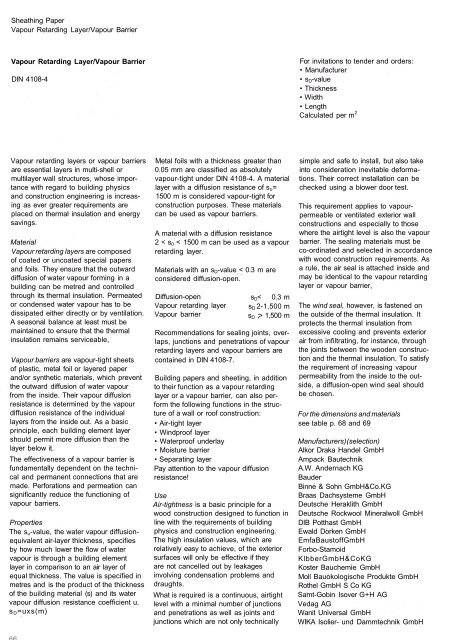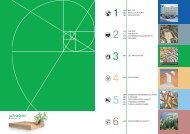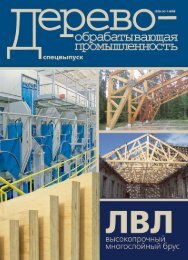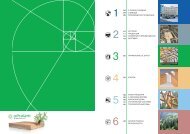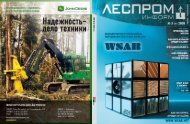Timber Construction
Timber Construction
Timber Construction
You also want an ePaper? Increase the reach of your titles
YUMPU automatically turns print PDFs into web optimized ePapers that Google loves.
Sheathing Paper<br />
Vapour Retarding Layer/Vapour Barrier<br />
Vapour Retarding Layer/Vapour Barrier<br />
DIN 4108-4<br />
Vapour retarding layers or vapour barriers<br />
are essential layers in multi-shell or<br />
multilayer wall structures, whose importance<br />
with regard to building physics<br />
and construction engineering is increasing<br />
as ever greater requirements are<br />
placed on thermal insulation and energy<br />
savings.<br />
Material<br />
Vapour retarding layers are composed<br />
of coated or uncoated special papers<br />
and foils. They ensure that the outward<br />
diffusion of water vapour forming in a<br />
building can be metred and controlled<br />
through its thermal insulation. Permeated<br />
or condensed water vapour has to be<br />
dissipated either directly or by ventilation.<br />
A seasonal balance at least must be<br />
maintained to ensure that the thermal<br />
insulation remains serviceable,<br />
Vapour barriers are vapour-tight sheets<br />
of plastic, metal foil or layered paper<br />
and/or synthetic materials, which prevent<br />
the outward diffusion of water vapour<br />
from the inside. Their vapour diffusion<br />
resistance is determined by the vapour<br />
diffusion resistance of the individual<br />
layers from the inside out. As a basic<br />
principle, each building element layer<br />
should permit more diffusion than the<br />
layer below it.<br />
The effectiveness of a vapour barrier is<br />
fundamentally dependent on the technical<br />
and permanent connections that are<br />
made. Perforations and permeation can<br />
significantly reduce the functioning of<br />
vapour barriers.<br />
Properties<br />
The su-value, the water vapour diffusionequivalent<br />
air-layer thickness, specifies<br />
by how much lower the flow of water<br />
vapour is through a building element<br />
layer in comparison to an air layer of<br />
equal thickness. The value is specified in<br />
metres and is the product of the thickness<br />
of the building material (s) and its water<br />
vapour diffusion resistance coefficient u.<br />
sD=uxs(m)<br />
Metal foils with a thickness greater than<br />
0.05 mm are classified as absolutely<br />
vapour-tight under DIN 4108-4. A material<br />
layer with a diffusion resistance of so=<br />
1500 m is considered vapour-tight for<br />
construction purposes. These materials<br />
can be used as vapour barriers.<br />
A material with a diffusion resistance<br />
2 < s0 < 1500 m can be used as a vapour<br />
retarding layer.<br />
Materials with an sD-value < 0.3 m are<br />
considered diffusion-open.<br />
Diffusion-open<br />
Vapour retarding layer<br />
Vapour barrier<br />
sD< 0.3 m<br />
sD 2-1,500 m<br />
sD ;> 1,500 m<br />
Recommendations for sealing joints, overlaps,<br />
junctions and penetrations of vapour<br />
retarding layers and vapour barriers are<br />
contained in DIN 4108-7.<br />
Building papers and sheeting, in addition<br />
to their function as a vapour retarding<br />
layer or a vapour barrier, can also perform<br />
the following functions in the structure<br />
of a wall or roof construction:<br />
• Air-tight layer<br />
• Windproof layer<br />
• Waterproof underlay<br />
• Moisture barrier<br />
• Separating layer<br />
Pay attention to the vapour diffusion<br />
resistance!<br />
Use<br />
Air-tightness is a basic principle for a<br />
wood construction designed to function in<br />
line with the requirements of building<br />
physics and construction engineering.<br />
The high insulation values, which are<br />
relatively easy to achieve, of the exterior<br />
surfaces will only be effective if they<br />
are not cancelled out by leakages<br />
involving condensation problems and<br />
draughts.<br />
What is required is a continuous, airtight<br />
level with a minimal number of junctions<br />
and penetrations as well as joints and<br />
junctions which are not only technically<br />
For invitations to tender and orders:<br />
• Manufacturer<br />
• sD-value<br />
• Thickness<br />
• Width<br />
• Length<br />
Calculated per m 2<br />
simple and safe to install, but also take<br />
into consideration inevitable deformations.<br />
Their correct installation can be<br />
checked using a blower door test.<br />
This requirement applies to vapourpermeable<br />
or ventilated exterior wall<br />
constructions and especially to those<br />
where the airtight level is also the vapour<br />
barrier. The sealing materials must be<br />
co-ordinated and selected in accordance<br />
with wood construction requirements. As<br />
a rule, the air seal is attached inside and<br />
may be identical to the vapour retarding<br />
layer or vapour barrier,<br />
The wind seal, however, is fastened on<br />
the outside of the thermal insulation. It<br />
protects the thermal insulation from<br />
excessive cooling and prevents exterior<br />
air from infiltrating, for instance, through<br />
the joints between the wooden construction<br />
and the thermal insulation. To satisfy<br />
the requirement of increasing vapour<br />
permeability from the inside to the outside,<br />
a diffusion-open wind seal should<br />
be chosen.<br />
For the dimensions and materials<br />
see table p. 68 and 69<br />
Manufacturers) (selection)<br />
Alkor Draka Handel GmbH<br />
Ampack Bautechnik<br />
A.W. Andernach KG<br />
Bauder<br />
Binne & Sohn GmbH&Co.KG<br />
Braas Dachsysteme GmbH<br />
Deutsche Heraklith GmbH<br />
Deutsche Rockwool Mineralwoll GmbH<br />
DIB Potthast GmbH<br />
Ewald Dorken GmbH<br />
EmfaBaustoffGmbH<br />
Forbo-Stamoid<br />
KlbberGmbH&CoKG<br />
Koster Bauchemie GmbH<br />
Moll Bauokologische Produkte GmbH<br />
Rothel GmbH S Co KG<br />
Samt-Gobin Isover G+H AG<br />
Vedag AG<br />
Wanit Universal GmbH<br />
WIKA Isolier- und Dammtechnik GmbH<br />
Damp-Proofing<br />
DIN 18195-1 to 10<br />
Building seals that meet the requirements<br />
of DIN 18195 are designed to prevent<br />
damage caused by pressing or nonpressing<br />
water as well as by ground<br />
moisture on the outside along the bordering<br />
building elements.<br />
Damp-proofing is also required to avert<br />
damage to wooden elements that could<br />
emanate from adjacent building elements<br />
such as concrete or masonry (building<br />
damp) or be caused by damp from the<br />
subsoil or weather.<br />
For these seals, which are not included in<br />
DIN 18195, other types of bituminous<br />
sheeting can be used than listed bare<br />
bitumen sheeting, asphalt roofing felt,<br />
asphalt roofing seal sheeting, bitumen<br />
seal sheeting, asphalt sheeting with different<br />
interply sheets: e.g. thick PE foil or<br />
other flexible plastic sheeting.<br />
Dimensions<br />
Bitumen sheeting<br />
Thickness (mm]: 4-5<br />
Width [cm]: 100<br />
Length [m]: 5<br />
Plastic sheeting<br />
Thickness [mm]: 1-3<br />
Width [cm]: 100,120, 130, 170,200<br />
Length [m]: 10,20,25<br />
Separating layers become necessary<br />
when different building materials are<br />
connected in such a way that their effectiveness<br />
is impaired or completely lost.<br />
Typical examples of this are separating<br />
layers on anticapillary courses underneath<br />
reinforced concrete floor slabs,<br />
separating layers between impact-sound<br />
insulation and wet lines, or between sheet<br />
covering and timber formwork, etc.<br />
The following materials can be considered<br />
for use as separating layers<br />
between different building elements:<br />
• Polyethylene foil<br />
• Polyester felts<br />
• Foam mats<br />
• Oil paper<br />
• Sodium bicarbonate kraft paper<br />
Sheathing Paper<br />
Damp-Proofing<br />
For invitations to tender and orders:<br />
• Manufacturer<br />
• DIN<br />
• Thickness<br />
• Width<br />
• Length<br />
Calculated by m 2<br />
Descriptions<br />
Bitumen sheeting<br />
Brief<br />
description<br />
R500"<br />
G 200 DD<br />
Designation<br />
Asphalt roofing felt with<br />
roofing felt intermediate ply<br />
Asphalt roofing seal<br />
sheeting<br />
V 13 Glass fibre asphalt<br />
roofing felt<br />
J300D Bitumen seal sheeting<br />
with jute cloth<br />
Al 0.2 D Bitumen seal sheeting<br />
with steel tape interply sheet<br />
V60S4 Asphalt sheeting<br />
with glass fibre interply sheet<br />
PV200 Polymer bitumen<br />
PYDD Roofing felt with polyester<br />
fleece interply sheet<br />
G200PYS5 Polymer bitumen sheeting<br />
i with glass fibre interply sheet<br />
Plastic Sheeting<br />
Brief<br />
description<br />
EPDM<br />
CSM<br />
MR<br />
NBR<br />
Designation<br />
Ethylene Propylene<br />
Diene Monomer<br />
Chlorsulfonated<br />
Polyethylene<br />
Butyl rubber (isobutyleneisoprene<br />
elastomer)<br />
Nitrile rubber (nitrile<br />
butadiene rubber)<br />
Manufacturers) (selection)<br />
A.W. Andernach KG<br />
Paul Bauder GmbH Co.<br />
Georg Borner GmbH & Co.<br />
Braas GmbH<br />
DLWAG<br />
Phoenix AG<br />
Saar-Gummiwerk GmbH<br />
Vedag AG<br />
Information<br />
Industrieverband Bitumen-<br />
Dach- und Dichtungsbahnen e.V.<br />
Wirtschaftsverband der<br />
deutschen Kautschukindustrie e.V.<br />
67


